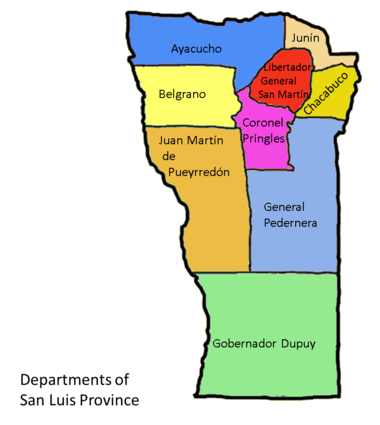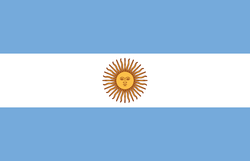San Luis Province, Argentina Genealogy
| Argentina Wiki Topics | |
| Beginning Research | |
| Record Types | |
| Argentina Background | |
| Local Research Resources | |
Guide to Province of San Luis family history and genealogy: birth records, marriage records, death records, church records, parish registers, and civil registration.
History[edit | edit source]
- In the eighteenth century the ethnic landscape had changed drastically after European immigration.
- In 1776 the Corregimiento de Cuyo was incorporated into the new Viceroyalty of the Río de la Plata.
- On November 29, 1813, the Interior Government of Cuyo was recreated, separating it from that of Córdoba del Tucumán.
- The province of San Luis has a population of approximately 490,000 people. [1]
Departments[edit | edit source]
 |
Getting started with research in San Luis[edit | edit source]
See FamilySearch Tutorials on Latin American Research.
Most of your genealogical research for Argentina will be in two main record types: civil registration and church records. This article will teach you methods for locating and searching these two record groups.
Civil Registration[edit | edit source]
- Civil registration records are government records covering birth, marriage, and death. They are an excellent source of names, dates, places, and relationships.
- Civil authorities began registering births, marriages, and deaths in 1886. Even though the law was passed in 1886 most of the provinces started keeping records at different times. Most had the system going by 1900.
- Every municipal district was to make duplicate copies of their books. In San Luis they kept the original books and send the copies to the Archivo General de Tribunales in the Federal District. In the provinces they were to be send the copies to the provincial or judicial archives of each province.
- According to the law, the public has liberal access to the civil records. The director of the civil archive is required to provide interested parties with a complete copy of any record, including marginal notes, under his jurisdiction.
- The Family History Library has not microfilmed the civil registration records of Argentina. The Library's collection continues to grow as new records are microfilmed and added to the collection from numerous sources. Don't give up if records are not available yet. The FamilySearch Catalog is updated periodically. Check it again every year for the records you need.
Locating Civil Registration Records[edit | edit source]
Civil registration records are kept at the local municipal district civil registration office (Dirección del Registro Civil). Therefore, you must determine the municipal district where your ancestor lived before you can find the records. The original book stays in the municipal office and duplicate copies are sent to the provincial or judicial archives of the province or the General Archive of the Tribunal in the federal district. Therefore, duplicates may also be available at the provincial level. If a letter to the town/city fails, write to the provincial office.
Your ancestor may have lived in a village that belonged civilly to a larger nearby town. In large cities, there may be many civil registration districts. You may need to use gazetteers and other geographic references to identify the place your ancestor lived and the civil registration office that served it. See Diccionario geográfico estadístico nacional argentino (1885). Although this gazetteer is in Spanish, the province is listed immediately after the name of the town.
Local Archives[edit | edit source]
Civil officials will generally answer correspondence in Spanish. Use the following address:
Dirección del Registro Civil
Oficina de Inscripciones y Rectificaciones
(*postal code) (City), (Province), Argentina
Provincial Archives and Tribunal Archives[edit | edit source]
These archives maintain the duplicates sent to them by the municipal districts. You may write to these archives and request searches of the records. The public has access to these records. For the province of San Luis, you will need to write to the following address:
Registro Provincial de las Personas
Junin 766
CP 5700 San Luis
Argentina
After deciding who has jurisdiction over the records for the time period you need, write a brief request to the proper office. Send the following:
- Full name and the sex of the person sought.
- Names of the parents, if known.
- Approximate date and place of the event.
- Your relationship to the person.
- Reason for the request (family history, medical, etc.).
- Request for a photocopy of the complete original record.
- Check or cash for the search fee (usually about $10.00).
Write your request in Spanish whenever possible. For writing your letter in Spanish, use the translated questions and phrases in this Spanish Letter-writing Guide.
Church Records[edit | edit source]
The vast majority of Argentines were Catholic and were registered in the records of the local parish or diocese which are called registros parroquiales (parish registers). These records include entries for baptisms, marriage information, marriages, deaths, and burials. Often two and sometimes three generations are indicated in the records. In addition, church records may include church censuses, account books, confirmations, and other church-related records.
Church records are crucial for genealogical research, since civil authorities did not begin registering vital statistics until after 1886. After this date one should search in both church and civil records as there may be information in one that does not appear in the other. For instance the church records may only list the godparents whereas the civil records may list the grandparents.
1. Online Digital Records for Church Records[edit | edit source]
For some localities, digital copies of Catholic church records can be searched online:
- 1645-1930 Argentina Baptisms, 1645-1930 at FamilySearch - How to Use this Collection; index
- 1722-1911 Argentina Marriages, 1722-1911 at FamilySearch - How to Use this Collection; index
Bautismos are infant baptisms, which are used for birth information. Información matrimonial are documents collected in preparation for a marriage. Matrimônios' are marriages. Defunciones are deaths. Entierros are burials'". Índice is the index.
2. Microfilm Copies of Church Records in the FamilySearch Catalog[edit | edit source]
If the locality and time period you need are not included in the online records, the next step is to find them in the microfilm collection of the Family History Library. Currently, they are being digitized, and plans are to complete that project by 2020. Check back occasionally to see if your records have become available. In the meantime, some of them might be available at a Family History Center near you.
To find a microfilm:
- a. Click on this link to see a list of records for Argentina, Province of San Luis.
- b. Click on "Places within Argentina, San Luis" and a list of towns and cities will open.
- c. Click on the town or city you wish to search.
- d. Click on "Church Records" topic. Click on the blue links to specific record titles.
- e. Choose the correct event and time period for your ancestor.
- f. Some combination of these icons will appear at the far right of the microfilm listed for the record.
 . Clicking on the magnifying glass will take you to the index. Clicking on the camera will take you to an online digital copy of the microfilm.
. Clicking on the magnifying glass will take you to the index. Clicking on the camera will take you to an online digital copy of the microfilm.
3. Writing to a Catholic Priest for Church Records[edit | edit source]
Baptism, marriage, and death records may be searched by contacting or visiting local parish or diocese archives in Argentina. Argentina has no single repository of church records. Write your request in Spanish whenever possible. This method is not always reliable. Officials might or might not respond.
Write a brief request in Spanish to the proper church using this address as guide replacing the information in parentheses:
- Reverendo Padre
- Parroquia de (name of parish)
- (postal code), (city), San Luis
- Argentina
When requesting information, send the following:
- Money for the search fee, usually $10.00
- Full name and the sex of the ancestor sought
- Names of the ancestor’s parents, if known
- Approximate date and place of the event
- Your relationship to the ancestor
- Reason for the request (family history, medical, and so on)
- Request for a photocopy of the complete original record
Write your request in Spanish whenever possible. For writing your letter in Spanish, use the translated questions and phrases in this Spanish Letter-writing Guide.]
Cemeteries[edit | edit source]
- 1882-2019 Argentina, Cemetery Records, 1882-2019 at FamilySearch — How to Use this Collection; index & images
Reading the Records[edit | edit source]
- You do not have to be fluent in Spanish to read your documents. Genealogical records usually contain a limited vocabulary. Use this Spanish Genealogical Word List to translate the important points in the document. Handwriting skills are taught in BYU Spanish Script Tutorial.
- Online Learning Center class on reading Spanish handwriting:
- Detailed instructions for reading Spanish records, examples of common documents, and practice exercises for developing skills in translating them can be found in the Spanish Records Extraction Manual.
- The Spanish Documents Script Tutorial also provides lessons and examples.
Tips for finding your ancestor in the records[edit | edit source]
Effective use of church records includes the following strategies.
- Search for the relative or ancestor you selected. When you find his birth record, search for the births of his brothers and sisters.
- Next, search for the marriage of his parents. The marriage record will have information that will often help you find the birth records of the parents.
- You can estimate the ages of the parents and determine a birth year to search for their birth records.
- Then repeat the process for both the father and the mother.
- If earlier generations (parents, grandparents, etc.) do not appear in the records, search neighboring parishes.
- Search the death registers for all known family members.
Research Tools[edit | edit source]
- How to read old handwriting tutorials
- BYU Research Outline for Argentina
- IGI Batch Numbers
- Listing of all records collections for Argentina available on FamilySearch.org
Wiki articles describing online collections are found at:
- Argentina Baptisms - FamilySearch Historical Records
- Argentina, National Census, 1869 - FamilySearch Historical Records
- Argentina, National Census, 1895 - FamilySearch Historical Records
- Argentina Marriages - FamilySearch Historical Records
Featured Content[edit | edit source]
Census[edit | edit source]
- Argentina Census
- 1869 Argentina, National Census, 1869 at FamilySearch - How to Use this Collection; index & images
- 1869 Argentina, National Census, 1869 at Ancestry - index & images ($)
- 1869 Argentina National Census 1869 at MyHeritage - index & images ($)
- 1895 Argentina, National Census, 1895 at FamilySearch - How to Use this Collection; index & images
- 1895 Argentina, National Census, 1895 at Ancestry - index & images ($)
- 1895 Argentina National Census, 1895 at MyHeritage - index & images ($)
Tutorials[edit | edit source]
Help Wanted[edit | edit source]
In order to make this wiki a better research tool, we need your help! Many tasks need to be done. You can help by:
References[edit | edit source]
- ↑ Wikipedia Collaborators, "Provincia de San Luis," In Wikipedia: The Free Encyclopedia, https://es.wikipedia.org/wiki/Provincia_de_San_Luis. Visited December 26, 2017.


